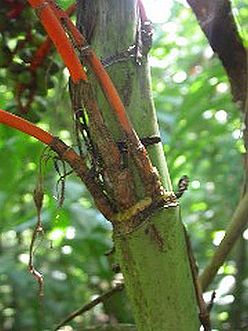Chamaedorea alternans
| Chamaedorea (kahm-eh-doh-REH-ah) alternans (AHL-tehr-nahns) | |||||||
|---|---|---|---|---|---|---|---|
 | |||||||
| Scientific Classification | |||||||
| |||||||
| Synonyms | |||||||
|
| |||||||
| Native Continent | |||||||
|
| |||||||
| Morphology | |||||||
| |||||||
| Culture | |||||||
|
| |||||||
| Survivability index | |||||||
|
| |||||||
| Common names | |||||||
|
| |||||||
Contents
Habitat and Distribution
Chamaedorea alternans is found in Southern Mexico, near the Gulf of Mexico in Veracruz and possibly Chiapas - in wet forest on the Atlantic slopes at elevations of 300-700 m.
Chamaedorea alternans is endemic to the remaining forests of Veracruz, Mexico. These forests mark the northern limit of the tropical rainforest ecosystem and are floristically interesting due to the combination of elements from the Caribbean, Central American, and mainland Mexican floras within a relatively restricted geographic area.
Description
Chamaedorea alternans is almost always solitary growing to a height of 3 m. with stems of 3-4 cm. It is uniformly pinnate and is distinguished by its almost unique white-margined leaf sheaths which display distinct venation, and by its bright orange rachillae. It is easily confused with Chamaedorea tepejilote, and even considered by some as a variation of this highly variable species.
Culture
It's native habitat and anecdotal evidence would indicate its cultural necessities are similar to many or the other Chamaedoreas - prefering shade, protection, and well draining moist soil, with some drought and minimal frost tolerance.
Comments and Curiosities
Chamadorea alternans was introduced to European gardens as early as 1875. It is now rarely seen in cultivation, and apparently most cultivated palms originated from the old seed bank of the International Palm Society in the 1980s.
This is one of the several Chamaedorea species which is harvested in habitat for its fronds in the floral industry. Although this does not appear to be near the risk to its existence as does the general deforestation of its natural habitat.
The epithet refers to the interesting manner in which the inflorescences alternate at the nodes from multiple to occasionally solitary.
Chamaedorea is a dioecious genus with male and female flowers occuring on separate plants. The Greek is translated to mean “gift on the ground” - possibly referring to the small stature and pleasant surprise of finding such a gem at your feet.
Chamaedorea are dioecious, male, and female flowers, on separate plants.
Etymology: In Latin; alternans meaning alternating, in reference to the pistillate inflorescences being solitary and then paired at alternating nodes.
- IMAGE GALLERY
External Links
References
Phonetic spelling of Latin names by edric.
Special thanks to Geoff Stein, (Palmbob) for his hundreds of photos.
Special thanks to Palmweb.org, Dr. John Dransfield, Dr. Bill Baker & team, for their volumes of information and photos.
Glossary of Palm Terms; Based on the glossary in Dransfield, J., N.W. Uhl, C.B. Asmussen-Lange, W.J. Baker, M.M. Harley & C.E. Lewis. 2008. Genera Palmarum - Evolution and Classification of the Palms. Royal Botanic Gardens, Kew. All images copyright of the artists and photographers (see images for credits).
Hodel, D.R.1992. Chamaedorea Palms, The Species and Their Cultivation. The International Palm Society.
Many Special Thanks to Ed Vaile for his long hours of tireless editing and numerous contributions.






